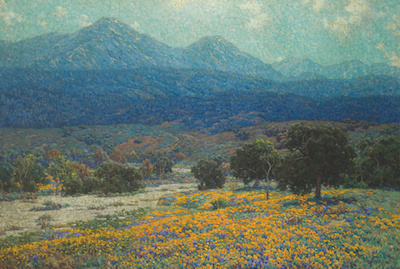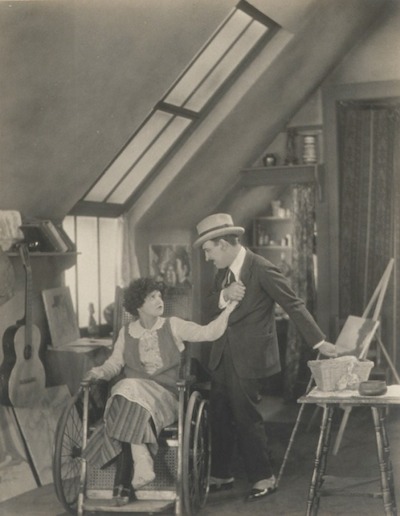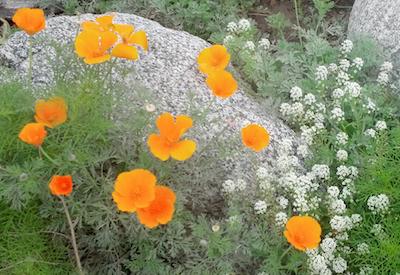Gardeners keep watch on rain and temperature to see how each season plays out against years past. Here in Southern California, late autumn rains predict brilliant spring blossoms. The current drought seemed destined to bring a dismal year for the California poppy and other wildflowers, however, rains in March helped our native plants, and the Antelope Valley California Poppy Preserve, located just north of Los Angeles, is having the best bloom in years.
 The California poppy with sweet alyssum, image courtesy of the author
The California poppy with sweet alyssum, image courtesy of the author
The California poppy opens at the same time as the arroyo lupine, and the red-orange color of the poppy complements the blue in the lupine, making both flowers appear more vivid. The California poppy’s scientific name Eschscholzia californica is a tribute to botanist Johann Friedrich von Eschscholtz, who traveled the western coast of North and South America as part of a voyage from 1815 through 1818 on the Rurik, a Russian exploratory ship.
Drive up to the preserve to see soft rolling hills spray painted in wide swaths of color, nature’s graffiti. If that is too far, visit LACMA to see Granville Redmond’s magnificent painting California Poppy Field.
 Granville Redmond, California Poppy Field, c. 1926, gift of Raymond Griffith
Granville Redmond, California Poppy Field, c. 1926, gift of Raymond Griffith
Redmond lost his hearing when he was very young after a severe bout of scarlet fever and never spoke. He learned to paint and to pantomime at the California School for the Deaf in Berkeley—skills that would uniquely combine to bring this painting to LACMA. When the art market collapsed during World War I, Redmond moved to Los Angeles to become a silent-film actor. Charlie Chaplin became interested in his pantomime skills, purchased some of his paintings, and had a painting studio built for him on the Chaplin studio lot at La Brea and Sunset Boulevard, about three miles from LACMA’s current campus.
This was a perfect place for the Hollywood crowd to see Redmond at work and to buy his paintings. He had roles in at least 10 silent films, including that of the sculptor in Chaplin’s City Lights (1931).
Silent-movie star and writer Raymond Griffith is not well known today, but in the 1920s, he was known as the “Silk Hat Comedian” due to the top hat and tuxedo that was often worn by the debonair character he portrayed. Griffith performed in vaudeville and the circus as a child and when "talkies” became popular, he became a movie producer. Griffith had lost his voice at an early age, but like Granville Redmond, his skills in pantomime brought him roles in silent films. LACMA owns a photograph of Griffith with Clara Bow from 1924, not long before his most famous films, Paths to Paradise (1926) and Hands Up (1927) were released.
 Karl Struss, Clara Bow and Raymond Griffith, 1924, gift of the Sid and Diana Avery Trust
Karl Struss, Clara Bow and Raymond Griffith, 1924, gift of the Sid and Diana Avery Trust
Griffith starred in A Regular Fellow (1925), a movie about a prince who falls in love, and in a murder mystery called You'd Be Surprised (1926). If he did not know Granville Redmond before then, they would have met on the sets of these films. In You’d Be Surprised, Griffith plays a coroner who tries to solve the crime and Redmond plays the dead man’s butler (the butler didn’t do it).
How does this circle back to poppies? Well, it goes back to Granville Redmond’s painting. Raymond Griffith bought California Poppy Field from Redmond, and five years after Redmond’s death in 1935, Griffith donated the artwork to the Museum of Natural History, Science and Art. The museum became two separate institutions in 1961: the Los Angeles Museum of History and Science and the Los Angeles County Museum of Art. At that point, Redmond’s painting became part of LACMA’s core art collection
California poppies close up each day in mid-afternoon. They unfurl their petals when the sun comes out the next day. When the sky is overcast, or if it is windy and cold, the flowers may not open up at all. Of all the plants collected on that long-ago Russian voyage, botanist Adelbert von Chamisso chose this flower to honor his friend and colleague Johann Friedrich von Eschscholtz; they must have seen poppies in bloom on their voyage.
Bring poppies into your life! They can be easy to grow: buy a pack of seed at a local hardware store in the fall, mix with a bit of sand, and toss them into a sunny spot. If it rains a bit and they like where they are, they will flower and reseed each year. Bring poppies into your home with LACMA’s print of Redmond’s California Poppy Field. And best of all, celebrate the flower that embodies California sunshine.
Carol Norcross, LACMA Store



